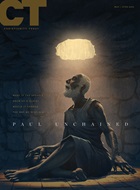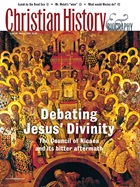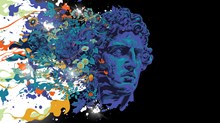The Council of Nicaea is often misrepresented. Jehovah's Witnesses and modern critics of the divinity of Christ allege that the council was merely a tool of imperial manipulation. They point to Nicaea, not the Bible, as the source of the doctrine of the Trinity, and interpret the Council as the triumph of heresy over orthodoxy, rather than the reverse. They argue that Emperor Constantine "forced" the Council to adopt the crucial word consubstantial (homoousios) to describe the equal divinity of the Father and the Son.
But did Constantine really run the show at Nicaea?
The relationship between the church and the emperors starting with Constantine to the end of the Roman Empire in the East (also known as the Byzantine Empire, A.D. 330-1453) worked much like a marriage. Much of it was improvised, and the lovers quarreled at times and manipulated each other to get what they wanted. When it came to matters of faith, however, the boundaries of their relationship left no uncertainty about where the power of one left off and the other began.
Defender of the Faith
In 336, the 30th year of Constantine's reign, Eusebius of Caesarea gave a speech in honor of the emperor. His talk provided an official statement of the imperial image and political theory that would define the role of the emperor until the fall of the Byzantine Empire: "Thus invested with the image of the kingship of heaven, he [the emperor] pilots affairs on earth while looking upward in order to steer according to the pattern of his archetype … He [God] has modeled the kingdom on earth into an image of that in heaven, and he urges all men to strive toward it."
Eusebius affirmed Constantine as God's anointed one, an earthly reflection of the image of Christ in heaven—one God, one emperor, one kingdom, and one faith. Eusebius did not believe Constantine was divine, but he did see him as God's representative over the Christian empire. Elsewhere he spoke of Constantine as the "supervisor of the people outside [the church]," which meant that Constantine had an apostolic mission to spread the gospel among the pagans. He was also the divinely appointed defender of the faith, the "pontifex maximus"—a Christianized pagan title for the supreme leader of religion which effectively made the church a department of the state. This meant that heresy and treason were equated. In the sixth century, Emperor Justinian described the relationship between church and empire as a harmonious "symphony."
What happened at Nicaea is true of all the ecumenical councils (A.D. 325-787) as they confessed the Trinity, the divine and human natures of Christ, and the justification of icons in worship and devotion. Four points summarize the relationship between church and emperor at all the ecumenical councils.
Who's in charge here?
First, the ecumenical councils were imperial councils. The emperors convened them and their proceedings were patterned after those of the Roman Senate. The emperors also confirmed the election of bishops, convened or prevented church councils, presided over them to some extent along with the bishops, maintained order and security, and closed the councils by ratifying their decisions and enforcing them as law.
The emperors could manipulate the outcome of a council convened by selecting which bishops would be invited, even though in theory it was to be open to all the bishops in the empire. The false council of Hieria in A.D. 754, which supported the destruction of icons, is a case in point.
At the Council of Nicaea, Constantine "pushed" the bishops to adopt the crucial term homoousios that was most likely suggested to him by his theological advisor, Bishop Ossius of Cordoba. Constantine was not a theologian—in fact, at the time, he was technically not even a Christian! But his push for closure resulted in consensus after only one day. His main goal was imperial unity, not theological accuracy. If the emperor had actually forced orthodoxy on the council, there would not have been the protracted debates and proliferation of theological parties in the decades that followed. (A similar controversy erupted in the aftermath of Chalcedon in 451).
Constantine was not the source of the term homoousios (it had been circulating among theologians for at least a century), nor did the council accept it at his command. He and subsequent Christian emperors could control the machinery of church affairs, but they could not decide matters of faith, which belonged to the bishops and their churches.
Innovation not a virtue
Second, the ecumenical councils were conservative. Doctrinal innovation was not a virtue in the minds of the emperors or early church fathers. Their task was not to invent doctrine, but to confess it. In so doing they characteristically appealed to "following the Holy Fathers" so that what had been believed would also be passed on. Hence the very words, phrases and sentences of the "holy and God-bearing Fathers" were endlessly collected and cited throughout the documents of the period.
Third, the councils functioned as witnesses to the truth. The councils were intended to be a manifestation of the church, not merely a forum to clarify differences. Their purpose was to take the consensus of what the bishops believed, not to determine truth through argumentation. The imperial council could not be a place to debate heretics who, by definition, could not even participate since they were in principle not members of the church. But the problem, of course, was to decide ahead of time who was a heretic, and that was seldom clear at the time. The emperors were only too eager to help clarify that issue.
Finally, the ecumenical councils were viewed as Spirit-inspired events, not as legal institutions that would guarantee the truthfulness of their decisions. This view limited imperial power. Constantine and his successors learned from the church's response that there was no guarantee a council's decisions would be accepted as representing the mind of the universal church. Under the guidance of the Holy Spirit, Nicaea was a witness to the truth, in conformity with the Scripture as handed down in apostolic tradition. But its ecumenicity and authority would be determined only by whether the church received it. The ultimate authority of all the ecumenical councils was not the emperor, but the witness of the Holy Spirit among the faithful and their bishops.
Unlike the doctrinal certainty which Rome later claimed to secure through the Pope, the Fathers of the ecumenical councils maintained that authority was to be found through the life of the Holy Spirit in the church. Thus the final authority was God himself, mediated through the body of Christ and its interpretation of the Bible. And thus the authority of the council was derived from its fidelity to Scripture. As Orthodox historian George Florovsky observed, "[T]he main, if not also the only, written manual of faith and doctrine, was in the ancient church, precisely Holy Scripture."
Bradley Nassif is professor of biblical and theological studies, North Park University, Chicago. He is the editor of New Perspectives on Historical Theology: Essays in Memory of John Meyendorff (Eerdmans, 1996), and author of the forthcoming Westminster Handbook to Eastern Orthodox Theology (2007).
Copyright © 2005 by the author or Christianity Today/Christian History & Biography magazine.
Click here for reprint information on Christian History & Biography.

Support Our Work
Subscribe to CT for less than $4.25/month





























